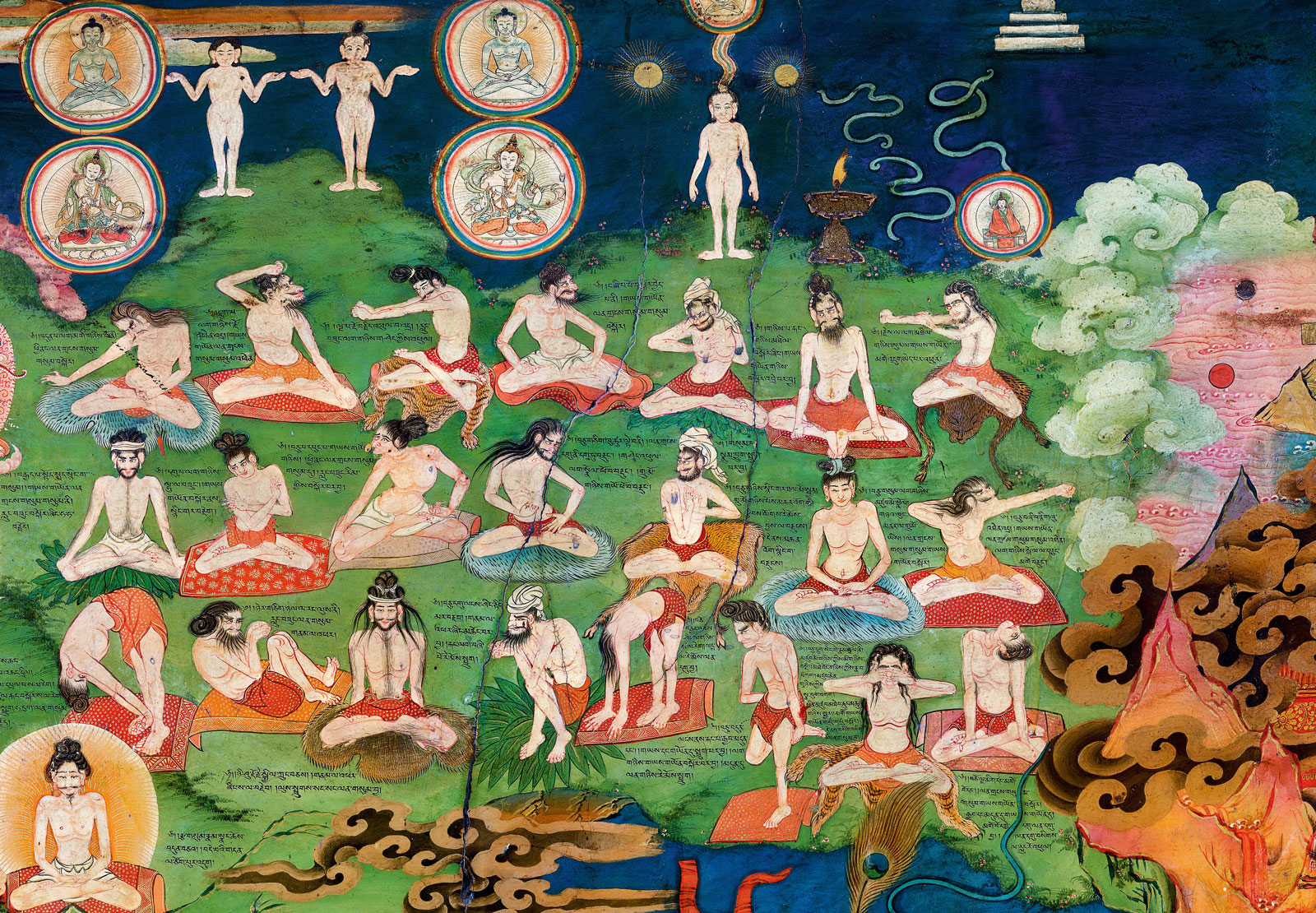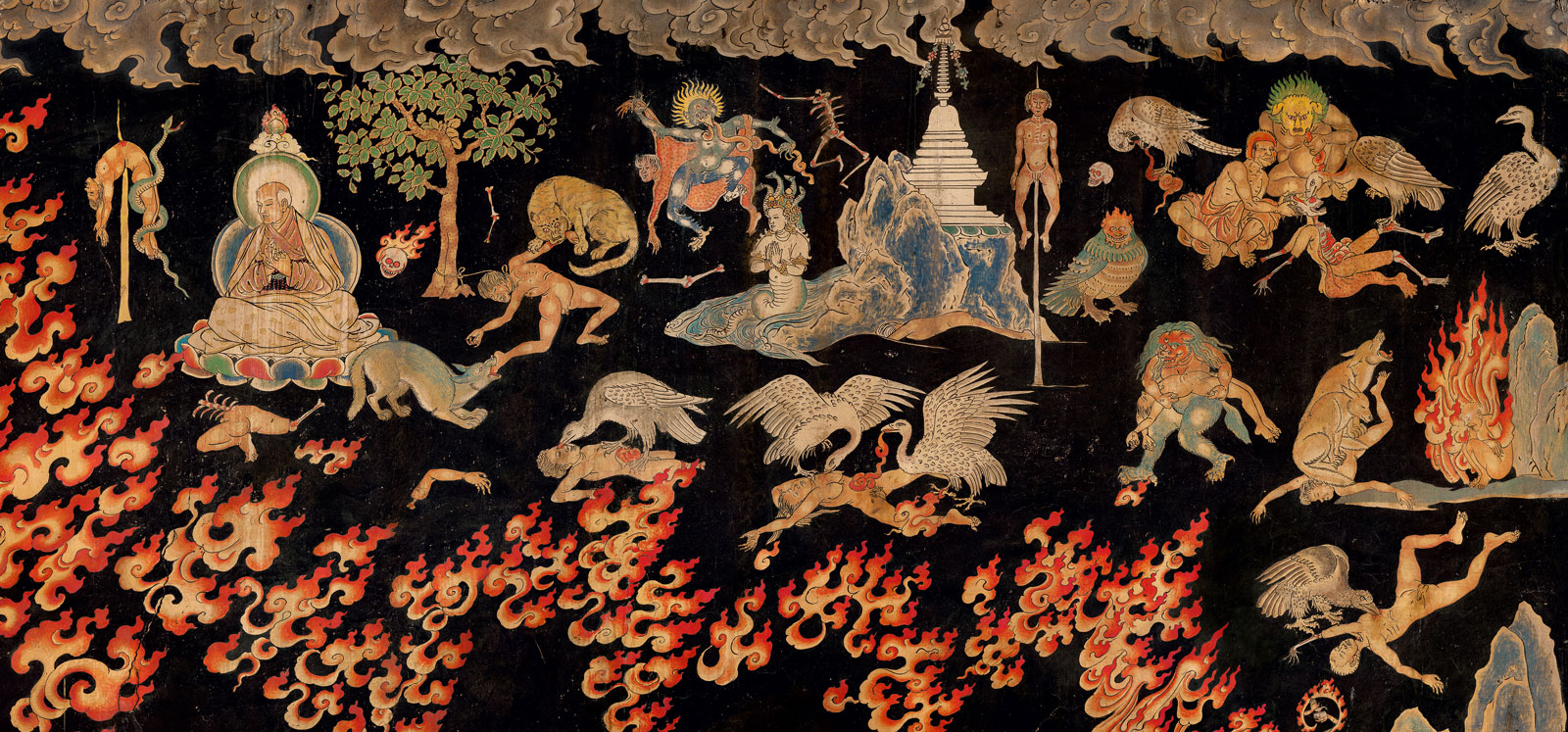An extraordinary book has recently gone on display at the Barakat Gallery in Los Angeles and the Taschen bookstore in New York City. Murals of Tibet, by the American photographer Thomas Laird, is not just extraordinary in size—the 500-page book is nearly 3 feet high and weighs 60 pounds—but also in level of detail. The exquisite reproductions of Tibetan paintings it contains are rendered with a precision never achievable before the advent of the high-resolution photographic methods Laird currently uses.
Murals of Tibet—each copy of which has been signed by His Holiness the 14th Dalai Lama in recognition of the book’s historic and artistic importance—is a crowning achievement of Laird’s distinguished career. As a photojournalist for TIME, National Geographic, and other magazines, Laird, 65, has been documenting the culture and history of the Himalayan Mountains and Tibetan plateau since 1972, when he arrived in Nepal at age 19. His book The Dalai Lama’s Secret Temple (Thames & Hudson, 2000) was the first to document the murals on the walls of the Lukhang Temple, the Dalai Lama’s exclusive meditation space in Lhasa, Tibet. Illustrating secret tantric initiations and yoga poses, the Lukhang murals had rarely been seen, let alone photographed, by Westerners before.

Laird has created full-size reproductions of the Lukhang murals and other Tibetan wall paintings by constructing them out of hundreds of individual photographs. (These reproductions were purchased in 2010 by the Rubin Museum in New York City, and are currently featured as part of their permanent collection.) Laird is also the author of the Story of Tibet (Grove/Atlantic, 2006), a history of the country based on conversations with the Dalai Lama, who has been a venerated mentor and guide in his quest to bring the murals of Tibet to the West.
I spoke to Laird shortly before the opening of the LA show about his personal spiritual journey, his work as a photographer, and his singular devotion to preserving the art of Tibet.
Your interest in Tibetan wall paintings began when you first saw the Lukhang murals in 1986. What were the circumstances that led you there?
I’d been living in Nepal for over ten years. Originally, I’d been working with a team of people on a grant to document examples of Himalayan art and rituals designed to achieve higher consciousness.
So you didn’t go to Nepal as a spiritual seeker.
Not really, although I quickly turned to Buddhism. I took refuge with His Holiness the 16th Karmapa [the late head of the Karma Kagyu lineage] around 1974 and received a visualization practice from Trulshik Rinpoche, the head of the Nyingma School and one of the Dalai Lama’s teachers. But, Tibetan and Himalayan art have shaped my life’s mission.
While you were in Nepal, you encountered some master painters as well as dharma teachers. Tell me about Auleshe.
Auleshe was a great Sherpa painter. I met him in 1974, and more than anybody, he set me on the path I’ve followed. He was a small, elfin man, a meditation practitioner as well as a painter, who lived in a cave outside the village of Junbesi in eastern Nepal.
He lived in a cave?
It was a beautiful cave, on a cliff in the middle of a virgin pine forest. The walls were rock, but his devotees and students had put in a wooden floor and glassed in the front, so you looked out over the trees. They’d also built a glass-enclosed workspace for him in front. It was one of the most unique dwellings I’ve ever seen.
You said Auleshe set you on your path. What was it about him that inspired you?
The way he would handle a painting. He did it with such reverence. It was clear that they weren’t just pigment on canvas; his art had deep spiritual meaning.
The Lukhang murals are filled with depictions of tantric and yogic practices. Was that surprising to you?
I’d never seen anything like them. There are illustrations of methods for intentional reincarnation, for instance, showing a yogi in the clouds radiating golden rays down to a couple having sex under a blanket in a charnel ground, surrounded by body parts. Another yogi’s head is erupting in flame while his sun and moon chakras open.

TASCHEN, Murals of Tibet
Where did these practices come from?
The murals themselves date to the time of the Fifth Dalai Lama in the late 17th century, but the Dzogchen (“Great Perfection”) practices they depict are based on the teachings of Pema Lingpa, the 15th-century Nyingma master. The artist was trying to make them seem even older, which is why the yogis in the paintings look Indian, with dreadlocks, hairy chests, and beards. The murals were designed to make people think that they were ancient teachings from India in order to lend them greater authenticity.
Related: Himalayan Buddhist Art 101
The murals were intended to instruct future Dalai Lamas. Why would you want to show tantric sex practices for intentional reincarnation to someone who has taken a vow of celibacy?
Because they may not have been intended for celibate Dalai Lamas.
What?
The Fifth Dalai Lama thought that reincarnation was a poor way to determine succession. Instead, he considered instituting a kingdom with patrilineal descent, from father to son, as a way to assure greater stability for Tibet as a nation.
Clearly, he didn’t succeed at doing away with the Dalai Lamas’ vows of celibacy. What happened?
His successor, the Sixth Dalai Lama, was notorious for his womanizing. But, it’s quite possible that his noncelibate behavior indicated his intention to follow through with the Fifth Dalai Lama’s idea. Ultimately, the Sixth Dalai Lama rejected the life of a monk altogether. He might have intended to found a hereditary lineage, but at 23, he was captured and probably murdered by the Mongols. As strict practitioners in the Gelug lineage, they were appalled by idea of a noncelibate Dalai Lama.
How long after you first saw the Lukhang murals did you start photographing them?
About a year or two later.
Since then, you’ve photographed hundreds of murals of Tibet. Why has this become your mission?
I’d spent years photographing Tibetan art and culture for magazines. Then, in 2001, the Taliban blew up the Buddhas of Bamiyan [sixth-century statues cut into a cliff wall] in Afghanistan. They’d been threatening to destroy them for over a year. I’d been trying to raise money to go there to photograph them, but I wasn’t able to do it in time. When they were destroyed, I felt a real sense of urgency and responsibility. I couldn’t do anything about Bamiyan, but I could do something to preserve the murals of Tibet.
What exactly is the threat to the murals?
Many were destroyed during the Cultural Revolution (1966–76). However, there’s a huge body of work that survived, and, today, the Chinese government is actually trying hard to preserve what remains. It’s almost impossible, though, even with the best efforts. The murals are scattered across the Tibetan plateau in remote, ancient, crumbling buildings. I’m not involved in the conservation work, but if my photographs can make people more aware of the art, and that increases efforts to conserve it, that’s fantastic.
Originally, you were taking standard-size photographs of the murals. Why did you switch to life-size reproductions?
I’d been attempting to take full-size photos of the murals for years, but I had to wait for advances in digital photography to catch up. It was only around 2009 that the extremely high-resolution photographic methods that I now use became available.
Can you walk me through the process of photographing a full-size mural?
Each mural requires hundreds of images. I’ll start in, say, the top left corner of the mural and shoot a single photo of a small section, perfectly lit, in full resolution, actual size with no enlargement. Then I repeat the process until I’ve finished the entire mural.
How do you put the pieces together?
Computer software can be used to render the pieces into a complete image, but I prefer putting them together by hand. The computer program can end up introducing distortions that I don’t like. I’m a control freak; I admit it. I need to control every aspect—the lighting, the camera rigging, the capture, the rendering, and the color correcting. I’m obsessive about it.
You’ve used the Tibetan word thongdrol, “liberation upon seeing,” to describe the Tibetan murals. Can you explain what you mean?
These murals are talking walls that convey a message from the time of the Buddha. They’re asking a question: “Are you listening? ARE YOU LISTENING?!” It’s like a two-by-four. Bam! You need to wake up if you want to hear what they have to say.